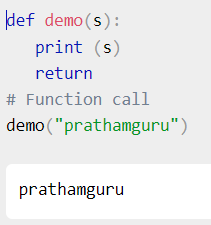Basics of python

Python is a computer programming language often used to build websites and software, automate tasks, and conduct data analysis. Python is a general-purpose language, meaning it can be used to create a variety of different programs and isn’t specialized for any specific problems.
Features of Python
Following are key features of Python −
- Python supports functional and structured programming methods as well as OOP.
- It can be used as a scripting language or can be compiled to byte-code for building large applications.
- It provides very high-level dynamic data types and supports dynamic type checking.
- It supports automatic garbage collection.
variables in Python
Variables are nothing but reserved memory locations to store values. This means that when you create a variable you reserve some space in memory. Let’s create a variable.
a = 10
Above, a is a variable assigned integer value 10.
Numeric Datatype in Python
Number data types store numeric values. They are immutable data types, means that changing the value of a number data type results in a newly allocated object.
Python supports four different numerical types.
-
int (signed integers) − They are often called just integers or ints, are positive or negative whole numbers with no decimal point.
-
long (long integers ) − Also called longs, they are integers of unlimited size, written like integers and followed by an uppercase or lowercase L.
-
float (floating point real values) − Also called floats, they represent real numbers and are written with a decimal point dividing the integer and fractional parts. Floats may also be in scientific notation, with E or e indicating the power of 10 (2.5e2 = 2.5 x 102 = 250).
-
complex (complex numbers) − are of the form a + bJ, where a and b are floats and J (or j) represents the square root of -1 (which is an imaginary number). The real part of the number is a, and the imaginary part is b. Complex numbers are not used much in Python programming.
Strings in Python
Strings are amongst the most popular types in Python. We can create them simply by enclosing characters in quotes. Python treats single quotes the same as double quotes. Creating strings is as simple as assigning a value to a variable.
Let’s see how to easily create a String in Python.
Lists in Python
The list is a most versatile datatype available in Python which can be written as a list of commaseparated values (items) between square bracket. Let’s see how to create lists with different types.
Tuples in Python
Tuples are sequences, just like lists. The differences between tuples and lists are, the tuples cannot be changed unlike lists and tuples use parentheses, whereas lists use square brackets.
Creating a tuple is as simple as putting different comma-separated values. Optionally you can put these comma-separated values between parentheses also. Let’s see how to create a Tuple.
Dictionary in Python
Dictionary is a sequence in Python. In a Dictionary, each key is separated from its value by a colon (:), the items are separated by commas, and the whole thing is enclosed in curly braces. Keys are unique within a dictionary while values may not be. The values of a dictionary can be of any type, but the keys must be of an immutable data type such as strings, numbers, or tuples.
Let’s see how to create a Dictionary −
Classes & Objects in Python
A class is a user-defined prototype for an object that defines a set of attributes that characterize any object of the class. The attributes are data members and methods, accessed via dot notation.
An object is a unique instance of a data structure that’s defined by its class. An object comprises both data members (class variables and instance variables) and methods.
Functions in Python
function is a block of organized, reusable code that is used to perform a single, related action. Functions provide better modularity for your application and a high degree of code reusing.
Function blocks begin with the keyword def followed by the function name and parentheses ( ( ) ). Let’s create a function.

